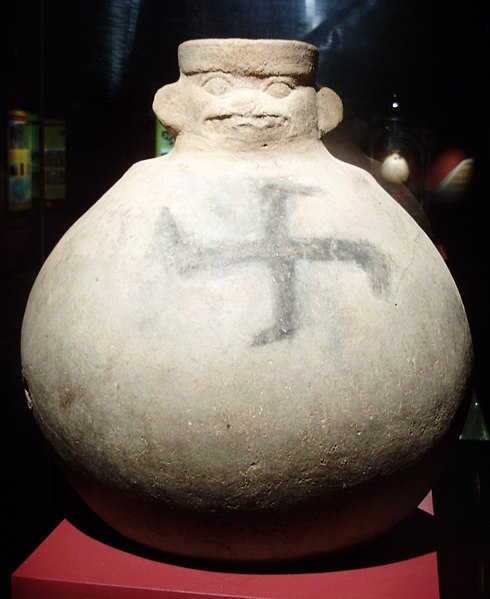File:Sican-Vessel-in-the-Huaca-Rajada-Site-Museum-001.JPG

Original file (1,878 × 2,296 pixels, file size: 1.61 MB, MIME type: image/jpeg)
Captions
Captions
Summary[edit]
| DescriptionSican-Vessel-in-the-Huaca-Rajada-Site-Museum-001.JPG |
English: Transitional non-ceremonial vessel dating from early Sican/Lambayeque period. The head in the top is a God. The artifact was found in a pyramid, in an administrative non-religius context. Due to the Swastika-like symbol that was painted on the vessel it has been nicknamed German vessel by the staff in the Huaca Rajada Site Museum where it is on display. The cross has been painted in carbon.
Español: Vasija no ceremonial que data de la etapa de transición entre los periodos Moche y Sicán/Lambayeque. La cabeza en la parte superior del cántaro representa a una divinidad. La pieza fue encontrada en la base de una pirámide de uso administrativo (no ceremonial). La cruz esvasticoide pintada sobre la pieza fue trazada con tintura a base de carbón y ha dado lugar a que este ceramio sea conocido familiarmente como vasija alemana por los conservadores del Museo de Sitio de Huaca Rajada (Lambayeque, Perú) donde actualmente se exhibe el artefacto. |
| Date | |
| Source | Own work |
| Author | Haylli |
| Camera location | 6° 48′ 01.84″ S, 79° 36′ 03.54″ W | View this and other nearby images on: OpenStreetMap |
|---|
Licensing[edit]
| Public domainPublic domainfalsefalse |
| I, the copyright holder of this work, release this work into the public domain. This applies worldwide. In some countries this may not be legally possible; if so: I grant anyone the right to use this work for any purpose, without any conditions, unless such conditions are required by law. |

|
Legal disclaimer This image shows (or resembles) a symbol that was used by the National Socialist (NSDAP/Nazi) government of Germany or an organization closely associated to it, or another party which has been banned by the Federal Constitutional Court of Germany. The use of insignia of organizations that have been banned in Germany (like the Nazi swastika or the arrow cross) may also be illegal in Austria, Hungary, Poland, Czech Republic, France, Brazil, Israel, Ukraine, Russia and other countries, depending on context. In Germany, the applicable law is paragraph 86a of the criminal code (StGB), in Poland – Art. 256 of the criminal code (Dz.U. 1997 nr 88 poz. 553). |
File history
Click on a date/time to view the file as it appeared at that time.
| Date/Time | Thumbnail | Dimensions | User | Comment | |
|---|---|---|---|---|---|
| current | 18:45, 11 October 2009 |  | 1,878 × 2,296 (1.61 MB) | Haylli (talk | contribs) | Position Corrected |
| 18:28, 11 October 2009 |  | 3,264 × 2,448 (3.29 MB) | Haylli (talk | contribs) | {{Information |Description={{es|1=Vasija no ceremonial que data de la etapa de transición entre los periodos Moche y Sicán/Lambayeque. La cabeza en la parte superior del cántaro representa a una divinidad. La pieza fue encontrada en la base de una pir� |
You cannot overwrite this file.
File usage on Commons
The following page uses this file:
File usage on other wikis
The following other wikis use this file:
- Usage on de.wikipedia.org
- Usage on it.wikipedia.org
- Usage on lt.wikipedia.org
Metadata
This file contains additional information such as Exif metadata which may have been added by the digital camera, scanner, or software program used to create or digitize it. If the file has been modified from its original state, some details such as the timestamp may not fully reflect those of the original file. The timestamp is only as accurate as the clock in the camera, and it may be completely wrong.
| Image title | OLYMPUS DIGITAL CAMERA |
|---|---|
| Camera manufacturer | OLYMPUS IMAGING CORP. |
| Camera model | FE310,X840,C530 |
| Exposure time | 1/5 sec (0.2) |
| F-number | f/3.3 |
| ISO speed rating | 125 |
| Date and time of data generation | 13:00, 12 September 2009 |
| Lens focal length | 6.2 mm |
| Orientation | 0 |
| Horizontal resolution | 314 dpi |
| Vertical resolution | 314 dpi |
| Software used | Picasa 3.0 |
| File change date and time | 13:00, 12 September 2009 |
| Y and C positioning | Co-sited |
| Exposure Program | Normal program |
| Exif version | 2.21 |
| Date and time of digitizing | 13:00, 12 September 2009 |
| APEX exposure bias | 0 |
| Maximum land aperture | 2.97 APEX (f/2.8) |
| Metering mode | Center weighted average |
| Light source | Unknown |
| Flash | Flash did not fire, compulsory flash suppression |
| Color space | Uncalibrated |
| Custom image processing | Normal process |
| Exposure mode | Auto exposure |
| White balance | Auto white balance |
| Digital zoom ratio | 1 |
| Scene capture type | Standard |
| Contrast | Normal |
| Saturation | Normal |
| Sharpness | Normal |
| Unique image ID | 560c87c14359dd583e04f74ba9292fb6 |